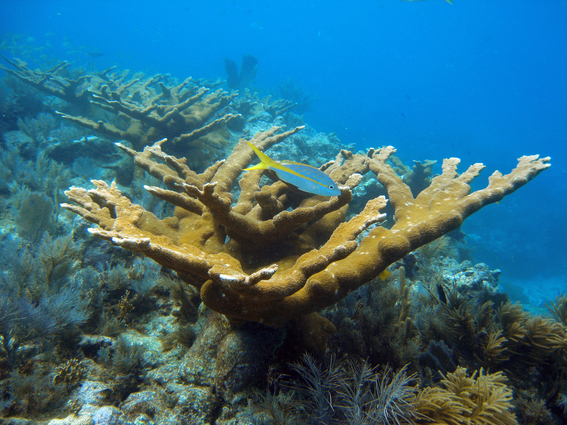Caribbean coral reef decline predates climate change damage
Researchers from the Scripps Institution of Oceanography at UC San Diego and Lawrence Livermore National Laboratory reconstructed a timeline of historical change in coral reefs near Bocas del Toro in Panama and discovered that damage to the area was caused by man as far back as the late 1800s.
The long-term decline in reef corals and mollusks is a result of a combination of stressors caused by land clearing and overfishing of reef fish that prevent algae from overtaking the reefs.
Already stressed reef systems are more susceptible to damage due to rising seawater temperatures and likely more susceptible to ocean acidification (the increase in acidity of ocean waters due to the transfer of fossil fuel CO2 from the atmosphere and into the ocean).
Though human-induced climate change since the 1980s has resulted in bleaching, disease and algal overgrowth in the area, the recent study quantitatively shows that earlier deforestation and overfishing were "degrading Caribbean coral and mollusk communities long before climate change impacts began to really devastate reefs," said Scripps alumna lead author Katie Cramer, currently based at the Global Coral Reef Monitoring Network at the International Union for Conservation of Nature.
Using radiocarbon dating techniques at Lawrence Livermore's Center for Accelerator Mass Spectrometry, Lab geochemist Tom Guilderson determined the age range of degradation as reflected in species composition and fossilization, and analyzed nearly a hundred coral skeletons excavated from the Bocas del Toro region.
Due to the dramatic increase in bomb-produced carbon 14 concentrations in surface ocean waters that began in the late-1950s and peaked in the mid-1970s, the team was able to distinguish samples from before and after circa 1960. Samples with calendar ages older than 1960 and 1960 or younger were labeled ''pre-bomb'' and ''post-bomb,'' respectively. Coral fragments with very high fraction modern values could be readily assigned post-bomb calendar ages, often with very high precision (A? 5 years or less).
The coral samples showed a decrease in the overall size of bivalves such as oysters, clams and scallops, a transition from branching to non-branching species of coral, and large declines in the staghorn coral and the tree oyster, which were once the dominant coral and bivalve on these reefs.
The radiocarbon ages of the deepest pre-bomb horizons varied greatly, from 50-750 years, although the majority of pits had maximum ages that extended back to the late 1700s or 1800s.
These changes in coral and mollusk communities demonstrate that reefs near Bocas del Toro experienced substantial ecological change before 1960 that was very likely under way by the 19th century.
The team concluded that the timing of these changes implicates historical local anthropogenic disturbances such as land clearing and fishing as ultimate causes. Human population and deforestation have increased substantially over the past century in the Bocas del Toro region, increasing runoff of sediments, nutrients and pollutants to adjacent coral reef environments that negatively impact corals.
Since the 1980s, coral cover in the Caribbean has declined by 80 percent on average and branching species have been replaced by non-branching species. The most recent dramatic changes have been attributed to human-induced climate change.
The research appears in the April edition of the journal, Ecology Letters.
Contact
Anne M Stark[email protected]
925-422-9799
Tags
Physical and Life SciencesFeatured Articles









